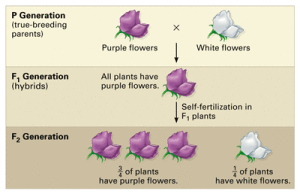Darwin’s Origin of Species is a sustained argument – almost 500 pages long – which aims to demonstrate that over millions of years all species of plants and animals have descended from original parents, along the way diversifying and/or going extinct, due to the process of natural selection.
(1) Starting with farm and garden (pages 45-49)
(2) Two key elements: variation and struggle (pages 49-55)
(1) Starting with farm and garden (pages 45-49)
Origin’s Chapter 1 points to the cross-breeding of plants and animals, which can produce new crop varieties or animals with more desirable traits. By intervening in the breeding process, a human breeder makes an act of selection – but for breeding to work, a species must already have variations which can potentially be passed on to descendents.
As to how variations originate, Darwin writes, “the laws governing inheritance are quite unknown…” but he rightly suspects that variability comes from the contributions of male and female reproductive elements that exist prior to conception. “The key is man’s power of accumulative selection: nature gives successive variations; man adds them up in certain directions useful to him.” With numerous examples of the human practice of breeding for advantageous traits, Darwin seeks to persuade readers that (1) species are not set in stone but are ‘plastic’ – that is, able to change across generations; and (2) natural selection is the means by which these results are obtained.
None of this argument was especially controversial. But by starting with domestic breeding practices, Darwin is setting the stage for his next argument – how selection must happen in undomesticated nature when there is no human mind to guide the process. He calls this process ‘Natural Selection’.

Gregor Mendel’s experiments with cross-breeding, conducted between 1856 and 1863,
established many of the rules of heredity – now referred to as the laws of Mendelian inheritance.
(2) Two key elements: variation and struggle (pages 49-55)
The prevailing idea in Darwin’s time was that every species on Earth had been separately created by a divine designer, who gave each species its own characteristics that remained fixed over time. But Darwin’s observations had taught him that no organism is fixed forever. Rather, each species has a variety of characteristics, seen and unseen, that can vary over time. In Origin’s Chapter 2, Darwin uses his new theory of evolution to interpret the puzzling range of data that all these variations present. He argues that the forms of life seen throughout his travels all belonged to groups which had emerged from other groups over time.
On the farm and in the garden, human breeders deliberately work to reproduce desirable characteristics. But if the natural world doesn’t operate through a divine designer, what governs the emergence of new characteristics? Chapter 3 paints a picture of the circumstances in which natural selection occurs. Darwin’s original readers thought of nature as a largely harmonious place, operating according to a pre-set design. But Darwin saw the reality: life is a struggle for all living organisms. Given Earth’s limited resources, every species produces more offspring than can possibly survive and, as organisms struggle to survive, some will die. In this endless interaction, certain variations will show up in offspring which give a small advantage – an edge in the search for nutrition and successful reproduction. Such variations spell success and, as they get passed on, become adaptations that spread through the group.
Johnson adds, “This is a deeply ecological vision of nature. It entails a network of intricate interdependence, expressed through competition for resources, or through profitable cooperation…
Johnson continues, “When we look at the natural world, without reference to a divine designer, we may be tempted to ascribe the result to chance. Surprisingly, Darwin rejects this idea…”
The natural world’s beauty is due to the mutual interactions of species in the struggle for life. “There is a sense to it, a reasonable explanation for it. Mutual interplay has created the living world as we know it.”
To add your comments or questions,
click on ‘Leave a Reply’ or ‘Replies’ (below).
After giving your name and email address,
your comments will be posted.
